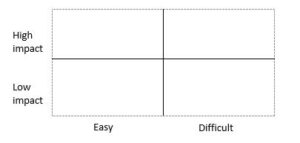The Value of Client Feedback: Spoiler—It’s Not Only about Clients
Recently, we’ve added the following polling question to our CPE webinars: “Does your firm have a formalized survey process for gathering client feedback?” More than 80% of respondents say they don’t.
Client feedback goes beyond electronic satisfaction surveys and net promoter scores. Meaningful intel on how your clients feel about their relationship with your firm is a key driver of client loyalty. But beyond that, there is another strategic purpose to gathering client feedback: staff retention.
A New Outcome of Client Feedback: Reduced Turnover
Firms that take time to formalize a process of gathering client feedback, evaluating consistencies and making purposeful choices about what to incorporate are better able to empower their team members to provide a meaningful experience. In contrast, firms that have no formalized way to evaluate what is important and what isn’t generally suffer (or more accurately, your people suffer) from the pressure of making every complaint, exception or suggestion appear equal. Your people may kill themselves trying to address every item individually causing redundancies, inefficiencies, employee burnout and, yes, turnover.
Client feedback is actually a path to better staff retention and even contributes to your ability to recruit and hire new people. A formalized process can be a real differentiator for your firm. We’ve helped firms large and small design, build and refine their client feedback processes. What’s common among them is a need to address the gap between learning and application. To glean value from the feedback leaders need to commit to applying what they learn by making systemic changes and engaging in training on the outcomes to be delivered. That’s where the magic happens.
Not only are there staff retention improvements, increasing the lifetime value of your client base by enhancing client retention levels significantly impacts your firm’s ability to grow its top-line because you aren’t constantly replacing revenue from clients that are leaving the firm. And loyal clients will refer business to you and serve as a reference if you ask…making it easier to attract new relationships as well.
Finally, working with loyal clients who recognize the value of the relationship with your firm, seek your counsel, are fun to serve and take your advice create for a very fulfilling practice. They create interesting professional opportunities and an enjoyable atmosphere. Who wouldn’t want to practice public accounting in an environment like that?
Understanding Satisfaction vs Loyalty
Satisfaction and loyalty are related, but not the same. Satisfaction is often tied to a project or engagement. Loyalty is tied to the relationship. Both are important – you can’t have loyalty without satisfaction first. But loyalty helps to insulate the relationship from brief periods of dissatisfaction. If I’m a loyal client, I’ll allow you the opportunity to fix a satisfaction issue. I may even become more loyal if the issue is resolved quickly and to my liking. However, if I’m merely satisfied, and then become dissatisfied I’m more likely to look for an alternative service provider because there is nothing else tethering me to the firm.
So ask yourself, “what are the proactive measures we are taking as a firm to measure and improve client loyalty?” If the answer is “not much” or “I’m not sure” you any want to consider starting at the beginning by understanding what your clients value in a relationship, and how you’re doing delivering in those key areas.
How do You Know What Clients Value? Ask!
Coordinated efforts to improve client service can yield some of the greatest returns on investment of any growth activity. To be most effective, any effort related to improving client service should germinate from feedback from your best clients. Often when firms measure satisfaction, they focus on engagement satisfaction. How satisfied were they with the outcome? How did they enjoy the experience of working with your team? What could you do differently? How would they rate the deliverables? While important, these surveys don’t adequately measure the satisfaction with the relationship—which is what drives loyalty.
Consider a formalized program to regularly learn the following from your clients:
- What attributes of service do they associate with your firm?
- What attributes of service are most important to them in hiring a CPA?
- How satisfied are they with your firm’s delivery of the attributes that are most important?
Don’t leave the task of evaluating feedback to your people in an ad hoc way. Put your team first by making strategic choices about what feedback is material, and what isn’t and then create systems, processes, training and tools that will enable them to deliver. Also, make sure that when you receive positive feedback about one of your team members you share it with the rest of the firm. (Create a culture of kudos!) Positive feedback goes a long way in creating goodwill with individuals and within the firm as a whole. In doing these things, clients will begin to see and feel the difference between your firm and others in the market.
Contact us today to get started on a program for your firm.

